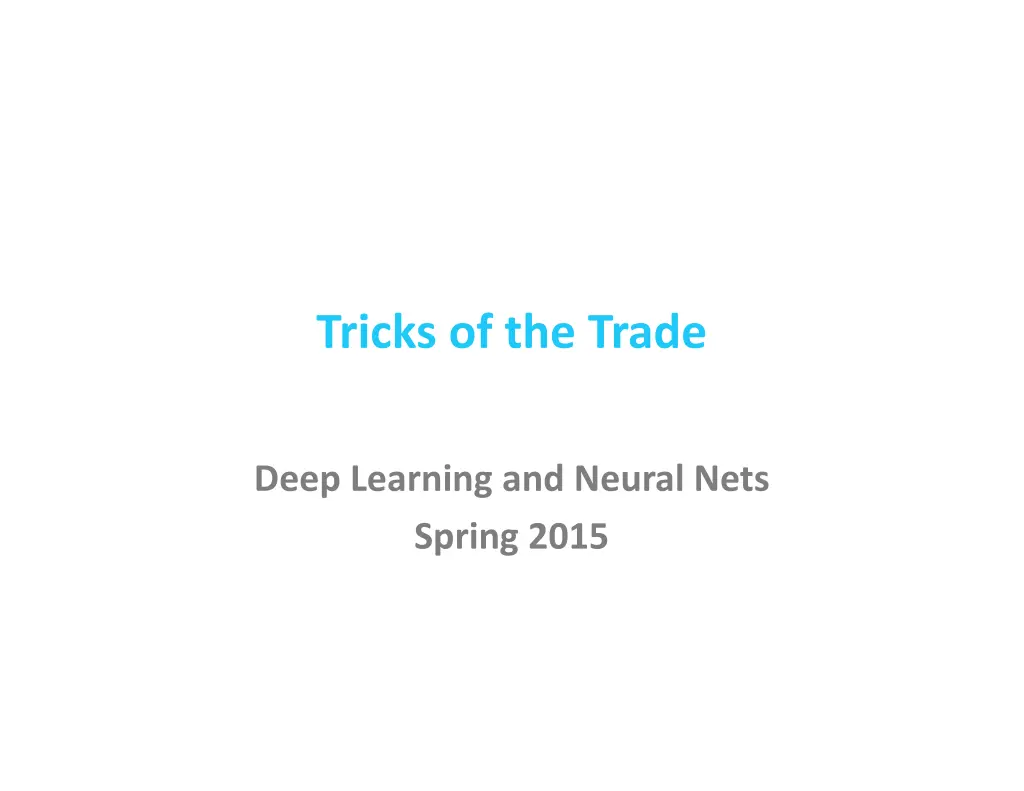
Tricks of the Trade: Deep Learning and Neural Nets Insights
Explore deep learning and neural networks concepts from a Spring 2015 course on cyberbullying, model fitting, generalizing architectures, activation functions, error functions, machine learning rules, model space, complexity, training vs. test set errors, bias-variance trade-off, and avoiding overfitting. Gain valuable insights into the latest tricks and techniques that impact performance in the field of artificial intelligence.
Download Presentation

Please find below an Image/Link to download the presentation.
The content on the website is provided AS IS for your information and personal use only. It may not be sold, licensed, or shared on other websites without obtaining consent from the author. If you encounter any issues during the download, it is possible that the publisher has removed the file from their server.
You are allowed to download the files provided on this website for personal or commercial use, subject to the condition that they are used lawfully. All files are the property of their respective owners.
The content on the website is provided AS IS for your information and personal use only. It may not be sold, licensed, or shared on other websites without obtaining consent from the author.
E N D
Presentation Transcript
Tricks of the Trade Deep Learning and Neural Nets Spring 2015
Agenda 1. Homa Hosseinmardi on cyberbullying 2. Model fitting and overfitting 3. Generalizing architectures, activation functions, and error functions 4. The latest tricks that seem to make a difference
Learning And Generalization What s my rule? 1 2 3 satisfies rule 4 5 6 satisfies rule 6 7 8 satisfies rule 9 2 31 does not satisfy Plausible rules 3 consecutive single digits 3 consecutive integers 3 numbers in ascending order 3 numbers whose sum is less than 25 3 numbers < 10 1, 4, or 6 in first column yes to first 3 sequences, no to all others rule
Whats My Rule For Machine Learning x1 x2 x3 y 0 0 0 1 0 1 1 0 1 0 0 0 1 1 1 1 0 0 1 ? 0 1 0 ? 1 0 1 ? 1 1 0 ? 16 possible rules (models) With N binary inputs and P training examples, there are 2(2^N-P)possible models.
Model Space restricted model class models consistent with data correct model All possible models Challenge for learning Start with model class appropriately restricted for problem domain
Model Complexity Models range in their flexibility to fit arbitrary data simple model high bias complex model low bias constrained low variance unconstrained high variance small capacity may prevent it from representing all structure in data large capacity may allow it to memorize data and fail to capture regularities
Training Vs. Test Set Error Test Set Training Set
Bias-Variance Trade Off Error on Test Set underfit overfit image credit: scott.fortmann-roe.com
Overfitting Occurs when training procedure fits not only regularities in training data but also noise. Like memorizing the training examples instead of learning the statistical regularities that make a 2 a 2 Leads to poor performance on test set Most of the practical issues with neural nets involve avoiding overfitting
Avoiding Overfitting Increase training set size Make sure effective size is growing; redundancy doesn t help Incorporate domain-appropriate bias into model Customize model to your problem Set hyperparameters of model number of layers, number of hidden units per layer, connectivity, etc. Regularization techniques smoothing to reduce model complexity
Incorporating Domain-Appropriate Bias Into Model Input representation Output representation e.g., discrete probability distribution Architecture # layers, connectivity e.g., family trees net; convolutional nets Activation function Error function
Customizing Networks Hinton softmax video lecture gives one example of how neural nets can be customized based on understanding of problem domain choice of error function choice of activation function Domain knowledge can be used to impose domain- appropriate bias on model bias is good if it reflects properties of the data set bias is harmful if it conflicts with properties of data
